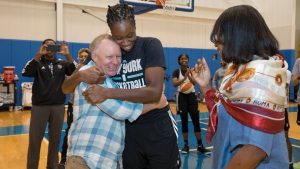- Slug: Sports-Hopey’s Heart, 633 words.
- 1 photo available
By Hayden Cilley
Cronkite News
PHOENIX– In the eyes of some, Phoenix Mercury forward Tina Charles is seen as one of the best scorers in the WNBA. For one man, she is viewed as a savior.
Dan Carlson, a Texas landscaping supervisor, had his life saved by an automated external defibrillator provided by Hopey’s Heart Foundation, a nonprofit organization that Charles started with a mission of equipping gymnasiums with AEDs to prevent sudden cardiac arrest.
“This is such a grassroots project that is so needed and saved my life,” Carlson said.
Carlson suffered a heart attack in July of 2017 while working at the Marbridge Foundation, a community for individuals with intellectual disabilities in Austin, Texas.
A coworker grabbed the AED and went to work saving Carlson.
Charles, 33, the reigning WNBA scoring champion who signed in January with the Mercury, lost a beloved aunt, Maureen “Hopey” Vaz, in 2013 to sudden cardiac arrest. Her aunt’s death, combined with the death two years earlier of Michigan high school player Wes Leonard, who collapsed on the court after making a game-winning layup, heightened her awareness of the need for AEDs. In particular, she noticed the absence of these devices in the gymnasiums she played in and at schools and other institutions.
Charles was in Poland, playing in the Euroleague, when she heard of Leonard’s death. Her aunt’s passing motivated her to start a foundation in her aunt’s memory and partner with other Euroleague players to provide AEDs to gymnasiums.
“Sudden cardiac arrest is indiscriminate towards race, age and gender,” Charles said.
According to the Cleveland Clinic, the heart’s electrical system sends impulses that trigger each heartbeat. Sudden cardiac arrest occurs when there’s a malfunction in the heart’s electrical system, which overrides the normal impulses. Nearly 356,000 sudden cardiac arrests occur outside of a hospital per year, according to the American Heart Association.
For all their differences, Leonard and Vaz had one thing in common: There was no AED present to resuscitate them after their collapses. Charles vowed to change that for others moving forward.
“Leading up to that year, I decided to make this my mission,” Charles said. “Just to raise awareness of cardiac arrest and the placement of AEDs.”
Since the foundation’s creation in April of 2013, 433 AED devices have been placed in North America, Europe, the Middle East and Asia. Hopey’s Heart Foundation has a partnership with the WNBA to match every rebound Charles pulls down to a dollar donation of the donors’ choosing. Considering Charles has averaged 9.5 rebounds per game in her 11-year career, the funds add up, making it possible to place AEDs in schools and other institutions.
As part of the application process, those wanting an AED device must write a 500-word essay explaining why it is needed.
“The way you see fire extinguishers is the way you should have an AED present,” Charles said. “The way you go through a fire drill in your institution is the way you should know what your AED program is within your institution.”
In September of 2017, two months after his cardiac arrest episode, Carlson visited the New York Liberty’s practice facility and met the woman who helped save his life. He had a multitude of emotions.
I felt joy, thankfulness, and closeness,” Carlson said. “I felt so proud of her. It was amazing that the first time I met her, I really felt close to her. I felt like I knew her.”
Because of the AED that Charles helped provide, Carlson has been able to experience life milestones for which he is so grateful.
“My daughter was pregnant with her first baby when my heart attack happened,” Carlson said. “I am grateful that I was around when the baby was born exactly six months after my heart attack. I appreciate my life.”
For more stories from Cronkite News, visit cronkitenews.azpbs.org.
